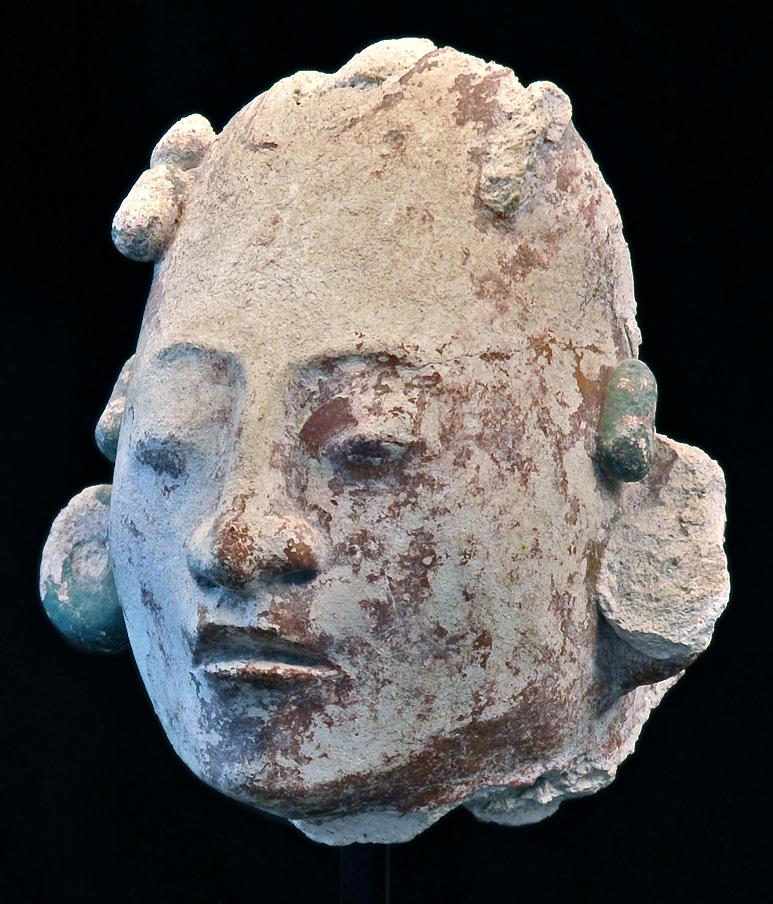

Title: Ancient Mayan Stucco Clay Ceramic Pottery Head Late Classic Period
Shipping: $29.00
Artist: N/A
Period: Antiquity
History: N/A
Origin: N/A
Condition: Museum Quality
Item Date: 550-950 AD
Item ID: 5946
MAYAN STUCCO HEAD. Late Classic period, 550-950 AD. 23 x 21 cm. With traces of original pigment including the famous Mayan blue. Provenance: An Italian collection. Purchased at Sotheby's New York, Nov. 24, 1997. Donated to Denver Museum of Art in 1970. Good and legal provenance provided to buyer. All of the art is edited and chosen by us for its high quality and workmanship before posting. We are committed to enhancing our customer’s lives by discovering creating, and pointing out only the best art we can find in the world today. We Are Taste-Makers, Art Advisers, Consultants & Publishers Of Spectacular Art Stories. Our job is to be intermediaries between buyers and sellers. We are vetting for high end art patrons. We are determined to catalog the world's most exceptional art and share it with everyone.
Link: http://en.wikipedia.org/wiki/Mayan_art
Figurines, many of them mold-made, are often of an amazing liveliness and realism. Apart from deities, animal persons, rulers and dwarfs, they show many other characters and scenes taken from daily life. Some of these figurines may have been used in rituals. The most impressive examples stem from Jaina Island.
Sculptural ceramic art includes incense burners and hand or mold-made figurines sometimes used as ocarina's. The profusely decorated, elongated Classic incense burners from the kingdom of Palenque - evolved from Early-Classic models - show the modeled face of a deity (usually the jaguar deity of terrestrial fire) or of a king. The elaborate Post-Classic, mold-made effigy incense burners especially associated with Mayapan represent standing deities (or priestly deity impersonators) often carrying offerings.
Unlike utility ceramics found in such large numbers among the debris of archaeological sites, most of the decorated pottery (cylinder vessels, lidded dishes, vases, bowls) once was 'social currency' among the Maya nobility, and, preserved as heirlooms, also accompanied the nobles into their graves. The aristocratic tradition of gift-giving feasts and ceremonial visits, and the emulation that inevitably went with these exchanges, goes a long way towards explaining the high level of artistry reached in Classical times.
The precious ceramic objects were manufactured in numerous workshops distributed over the Mayan kingdoms, some of the most famous being associated with the 'Chama-style', the 'Holmul-style', and the so-called 'Ik-style'. Made without a potter's wheel, they were delicately painted, carved into relief, incised, or - chiefly during the Early Classic period - made with the Teotihuacan fresco technique of applying paint to a wet clay surface.
Vase decoration shows great variation, including palace scenes, courtly ritual, mythology, divinatory glyphs, or even dynastical texts taken from chronicles, and plays a major role in reconstructing Classical Maya life and beliefs. Ceramic scenes and texts painted in black and red on a white underground, the equivalents of pages from the lost folding books, are referred to as being in 'codex style'; the hieroglyphical and pictural overlap with the three extant books is relatively small.
Ancient Maya art refers to the material arts of the Maya civilization, an eastern and south-eastern Mesoamerican culture that took shape in the course of the later Preclassic period (500 BC to 200 AD), saw its greatest flowering during the seven centuries of the Classic period (c. 200 to 900 AD), and went through an extended Postclassic phase before the upheavals of the sixteenth century destroyed courtly culture and put an end to the Mayan artistic tradition. Many regional styles existed, not always coinciding with the changing boundaries of Mayan polities. Olmecs, Teotihuacan and Toltecs have all influenced Maya art. Traditional art forms have mainly survived in weaving and the design of peasant houses.